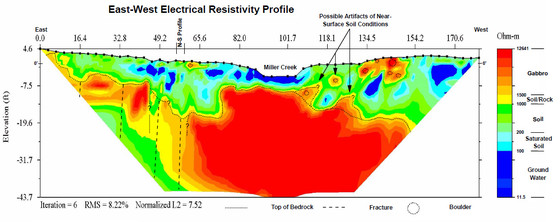Innovation of the Month:
A-GaME: Advanced Geotechnical Methods in Exploration
Through the month of June, we introduced you to A-GaME and shared several techniques in its toolbox. States using A-GaME commonly report that there is no single method or combination of methods that works for all projects. We encourage you to consider all advanced geotechnical methods and select the appropriate ones for your projects.
The Minnesota Department of Transportation (MnDOT) has successfully used multiple A-GaME techniques for years, and routinely uses alternative geotechnical methods throughout the project lifecycle, wherever appropriate.
In one case, MnDOT expected highly variable bedrock in the vicinity of planned bridge structure in Duluth, MN. Due to its sensitive location near a trout stream, it was undesirable to clear trees and vegetation for traditional site characterization. Instead, the agency used an A-GaME technique called electrical resistivity to identify the irregular bedrock surface and create an interpreted profile. MnDOT used this information to successfully complete the project with minimal disturbance to the site. This project relied solely on geophysical methods for foundation investigation. While relying on geophysical methods alone is uncommon, this project illustrates that proven yet non-conventional approaches can help agencies successfully characterize sites while considering specific project risks.
To learn how your agency can integrate these proven, innovative geotechnical methods into its site characterization program, contact Ben Rivers of the FHWA Resource Center or Silas Nichols of the FHWA Office of Infrastructure.
 This electrical resistivity profile of the site in Minnesota revealed potential areas of irregular bedrock to engineers during the planning phase.
Putting the Spotlight on Weather Responsive Management Strategies
In a recent episode of AASHTO’s Snow and Ice Cooperative Program podcast devoted to all things Winter Maintenance, SICOP Talks Winter OPS, EDC-5 Deployment Team Leader Roemer Alfelor discussed how various mobile road weather data sources can support enhanced traffic and maintenance management strategies in inclement weather.
Listen to the episode now to learn how weather responsive management strategies can help improve safety and mobility on your roads during adverse weather.
Joint Webinar Shows Synergy in EDC-5 Initiatives
On July 18, 2019, from 12:00-1:30pm ET, EDC-5 teams for weather responsive management strategies (WRMS) and crowdsourcing for operations will hold a joint webinar, Using Mobile and Crowdsourced Data for Weather Responsive Management Strategies.
This webinar explores the use of mobile applications and crowdsourced data to support weather responsive management strategies. Practitioners from Wyoming Department of Transportation, Utah Department of Transportation, and Kentucky Transportation Cabinet will discuss their successes managing adverse road weather events using these data sources.
Register now for this webinar. For additional information on WRMS, contact Roemer Alfelor and for more information on Crowdsourcing for Operations, contact James Colyar, both with the FHWA Office of Operations.
|